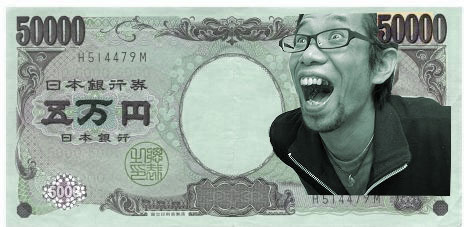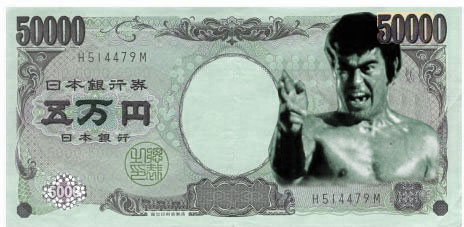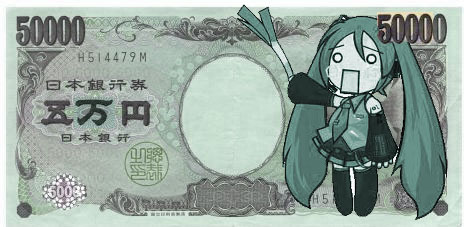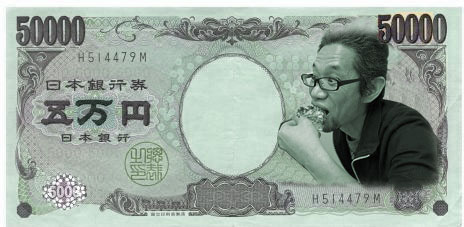 A major flaw of Japanese currency is the 10,000 yen bill ceiling of banknotes.
A major flaw of Japanese currency is the 10,000 yen bill ceiling of banknotes.
For daily life, having a system of bills which max out at around 100 bucks US is not a problem. But for those special times when you want to buy something high-end like a computer or melons, your wallet suddenly swells to the size of a baseball. In country that largely shuns checks or debit cards, cash is still king – a thick, hard to fit in your back pocket king.
Rumors are swirling about financial reforms in the works by Shinzo Abe’s recently elected Liberal Democratic Party involving, among other things, the issuing of 50,000 yen bills. Yes, it looks like – for once – a politician is looking out for the needs of people with too much money.
Shortly after his election win last September, Prime Minister Abe had been promoting several ideas to breathe life back into Japans flailing economy. These include the old lowering of the yen agendas that pundits have dubbed “Abenomics.”
As a general rule of politics, when people combine your name with your policies it means they’re not thrilled with them. Nevertheless, Abe and his cabinet are unfazed by criticisms with deeper plans in the works under the guidance of former Yale University professor Kōichi Hamada.
These plans involve bringing the inflation rate to a 2% target by 2014 leading to what the government refers to as an “indefinite monetary easing” scheme.
This indefinite monetary easing scheme is believed to involve a restructuring of the relationship between the Bank of Japan and the government. Previously the government held tight control over the central bank’s actions with it sometimes being referred to as “nothing more than a printing machine”.
However, now it’s possible that steps are being taken to create a more cooperative system of monetary policy hoping to improve over the formerly used “quantitative easing” which has yielded unimpressive economic results.
With nothing set in stone, some still feel this move is likely considering Abe’s Minister of Financial Services (and former PM) Taro Aso, is roughly of the same mind.
As a result of all this power shifting and economics, one potential plan of consumer stimulus that has this consumer so stimulated he needs a shower is the 50,000 yen banknote.
No more will we have to carry around briefcases of cash like a villain from a Lethal Weapon movie to make a major purchase. Finally large sums of cash may be able to fit discretely in our wallets and purses.
Still, the 50,000 yen question remains: Who would be on the bill?
Abe’s sometimes hardline leanings may suggest he’s a little full of himself and would try to put himself on the bill.
However, bills in Japan tend to feature noted historical people outside of the political sphere as well. Who’s the symbol of Japan these days?
Yes. This is it.
Source: ZakZak via My Game News Flash (Japanese)




 Man counterfeits 50,000 yen using only a 100-yen shop, a convenience store, and a Japanese custom
Man counterfeits 50,000 yen using only a 100-yen shop, a convenience store, and a Japanese custom Why was the 2,000-yen bill left out of Japan’s yen redesign, and how does it feel about the snub?
Why was the 2,000-yen bill left out of Japan’s yen redesign, and how does it feel about the snub? Private booths are coming to Japan’s Shinkansen bullet trains even sooner than we’d thought【Video】
Private booths are coming to Japan’s Shinkansen bullet trains even sooner than we’d thought【Video】 Top Japanese cosplayer Enako returns to Comiket after 6 years, creates mayhem with admirers
Top Japanese cosplayer Enako returns to Comiket after 6 years, creates mayhem with admirers Majority of Japanese mayors say foreign residents are essential but most see good and bad effects
Majority of Japanese mayors say foreign residents are essential but most see good and bad effects 7 great places to see Mt. Fuji from without having to climb it
7 great places to see Mt. Fuji from without having to climb it What makes this new Japanese convenience store chain better than 7-Eleven?
What makes this new Japanese convenience store chain better than 7-Eleven? The Purple Lucky Bag from Village Vanguard is an extra-large waste of money
The Purple Lucky Bag from Village Vanguard is an extra-large waste of money Four Shinto shrines to pray for love at in Japan to start the New Year
Four Shinto shrines to pray for love at in Japan to start the New Year We travel to Yamanashi to try the water cake that disappears in 30 minutes!【Taste Test】
We travel to Yamanashi to try the water cake that disappears in 30 minutes!【Taste Test】 Japan’s human washing machines will go on sale to general public, demos to be held in Tokyo
Japan’s human washing machines will go on sale to general public, demos to be held in Tokyo Starbucks Japan ready to get Year of the Horse started with adorable drinkware and plushies【Pics】
Starbucks Japan ready to get Year of the Horse started with adorable drinkware and plushies【Pics】 Hayao Miyazaki says Happy New Year to Studio Ghibli fans with new art for Year of the Horse
Hayao Miyazaki says Happy New Year to Studio Ghibli fans with new art for Year of the Horse Japanese beef bowl chain Sukiya’s 2026 Smile Box lucky bag basically pays for itself
Japanese beef bowl chain Sukiya’s 2026 Smile Box lucky bag basically pays for itself We found possibly the quietest Japanese-style hotel in Tokyo’s bustling Shinjuku district
We found possibly the quietest Japanese-style hotel in Tokyo’s bustling Shinjuku district Cup Noodle tries an authentic Jiro-style ramen, but something’s not quite right
Cup Noodle tries an authentic Jiro-style ramen, but something’s not quite right The best Starbucks Japan Frappuccinos we want to drink again in 2026
The best Starbucks Japan Frappuccinos we want to drink again in 2026 We revisited Sweets Paradise after a decade to see if Japan’s dessert buffet still delivers
We revisited Sweets Paradise after a decade to see if Japan’s dessert buffet still delivers That time Seiji called JASRAC to ask why he didn’t get paid royalties for his song being on TV
That time Seiji called JASRAC to ask why he didn’t get paid royalties for his song being on TV Japan’s oldest largetooth sawfish in captivity back on display in Mie Prefecture
Japan’s oldest largetooth sawfish in captivity back on display in Mie Prefecture Pizza Hut Japan’s hot lucky bags are perfect for a New Year’s pizza party
Pizza Hut Japan’s hot lucky bags are perfect for a New Year’s pizza party 7-Eleven Japan starts new temporary luggage storage service in over 300 branches
7-Eleven Japan starts new temporary luggage storage service in over 300 branches Disillusionment at Tsukiji’s tourist-target prices led us to a great ramen restaurant in Tokyo
Disillusionment at Tsukiji’s tourist-target prices led us to a great ramen restaurant in Tokyo Starbucks teams up with 166-year-old Kyoto doll maker for Year of the Horse decorations【Photos】
Starbucks teams up with 166-year-old Kyoto doll maker for Year of the Horse decorations【Photos】 Tokyo considering law requiring more trash cans following litter increase in heavily touristed area
Tokyo considering law requiring more trash cans following litter increase in heavily touristed area Tokyo’s Tsukiji sushi neighborhood asks tour groups to stay away for the rest of the month
Tokyo’s Tsukiji sushi neighborhood asks tour groups to stay away for the rest of the month Tokyo event lets you travel back in time, for free, to celebrate 100 years since Showa era start
Tokyo event lets you travel back in time, for free, to celebrate 100 years since Showa era start Japan may add Japanese language proficiency, lifestyle classes to permanent foreign resident requirements
Japan may add Japanese language proficiency, lifestyle classes to permanent foreign resident requirements Sanrio theme park in Japan announces plans to expand into a Sanrio resort
Sanrio theme park in Japan announces plans to expand into a Sanrio resort Stamina-destroying “Paralysis Noodles” are Tokyo’s newest over-the-top ramen innovation
Stamina-destroying “Paralysis Noodles” are Tokyo’s newest over-the-top ramen innovation Survey asks foreign tourists what bothered them in Japan, more than half gave same answer
Survey asks foreign tourists what bothered them in Japan, more than half gave same answer Japan’s deadliest food claims more victims, but why do people keep eating it for New Year’s?
Japan’s deadliest food claims more victims, but why do people keep eating it for New Year’s? We deeply regret going into this tunnel on our walk in the mountains of Japan
We deeply regret going into this tunnel on our walk in the mountains of Japan Studio Ghibli releases Kodama forest spirits from Princess Mononoke to light up your home
Studio Ghibli releases Kodama forest spirits from Princess Mononoke to light up your home Major Japanese hotel chain says reservations via overseas booking sites may not be valid
Major Japanese hotel chain says reservations via overseas booking sites may not be valid Put sesame oil in your coffee? Japanese maker says it’s the best way to start your day【Taste test】
Put sesame oil in your coffee? Japanese maker says it’s the best way to start your day【Taste test】 No more using real katana for tourism activities, Japan’s National Police Agency says
No more using real katana for tourism activities, Japan’s National Police Agency says Starbucks Japan reveals new sakura drinkware collection, inspired by evening cherry blossoms
Starbucks Japan reveals new sakura drinkware collection, inspired by evening cherry blossoms Updated cherry blossom forecast shows extra-long sakura season for Japan this year
Updated cherry blossom forecast shows extra-long sakura season for Japan this year
Leave a Reply